Abstract
OBJECTIVES: To determine the blood lead levels in children and to identify risk factors for elevated levels. DESIGN: Cross-sectional study. SETTING: Vancouver. PARTICIPANTS: Random sample of children aged 24 to 36 months, born and still resident in Vancouver. The sample was stratified proportionally by the median annual family income in the census tract where each family resided. OUTCOME MEASURES: Blood lead levels and risk factors for elevated blood lead levels, determined from a questionnaire administered to parents. RESULTS: Of the children in the sample, 42% (178/422) were ineligible or could not be located. Of the remaining children, 73% (177/244) participated and adequate blood specimens were obtained from 172. The mean blood lead level was 0.29 mumol/L (standard deviation 0.13 mumol/L). (A blood lead level of 1 mumol/L is equivalent to 20.7 micrograms/dL.) The lowest level was 0.06 mumol/L, and the highest was 0.85 mumol/L. Of children with adequate samples, 8.1% (14/172) had blood lead levels of 0.48 mumol/L or higher, and 0.6% (1/172) had a level higher than 0.72 mumol/L. The logarithms of the levels were normally distributed, with a geometric mean (GM) of 0.26 mumol/L (geometric standard deviation 1.56). Of approximately 70 possible predictors of blood lead levels analysed, those that showed a statistically significant association (p < 0.05) with increased blood lead levels were soldering performed in the home as part of an electronics hobby (GM blood lead level 0.34 mumol/L, 95% confidence interval [CI] 0.27 to 0.39 mumol/L), aboriginal heritage (GM blood lead level 0.33 mumol/L, 95% CI 0.28 to 0.39 mumol/L), dwelling built before 1921 (GM blood lead level 0.32 mumol/L, 95% CI 0.28 to 0.37 mumol/L), age of water service connection to dwelling (predicted blood lead level 0.00087 mumol/L [95% CI 0.00005 to 0.00169 mumol/L] higher per year since service connection) and decreased stature (predicted blood lead level 0.018 mumol/L [95% CI 0.0353 to 0.0015 mumol/L] higher for every standard deviation below the age-specific mean height). CONCLUSIONS: This study found much lower blood lead levels in children than those found in previous Canadian studies. The authors believe that this result is not an artefact due to differences in population sampling or methods of collection of blood specimens. The study showed no clear risk factors for elevated blood lead levels: although a few factors had a statistically significant association with increased blood lead levels, the differences in levels were small and unimportant.
Full text
PDF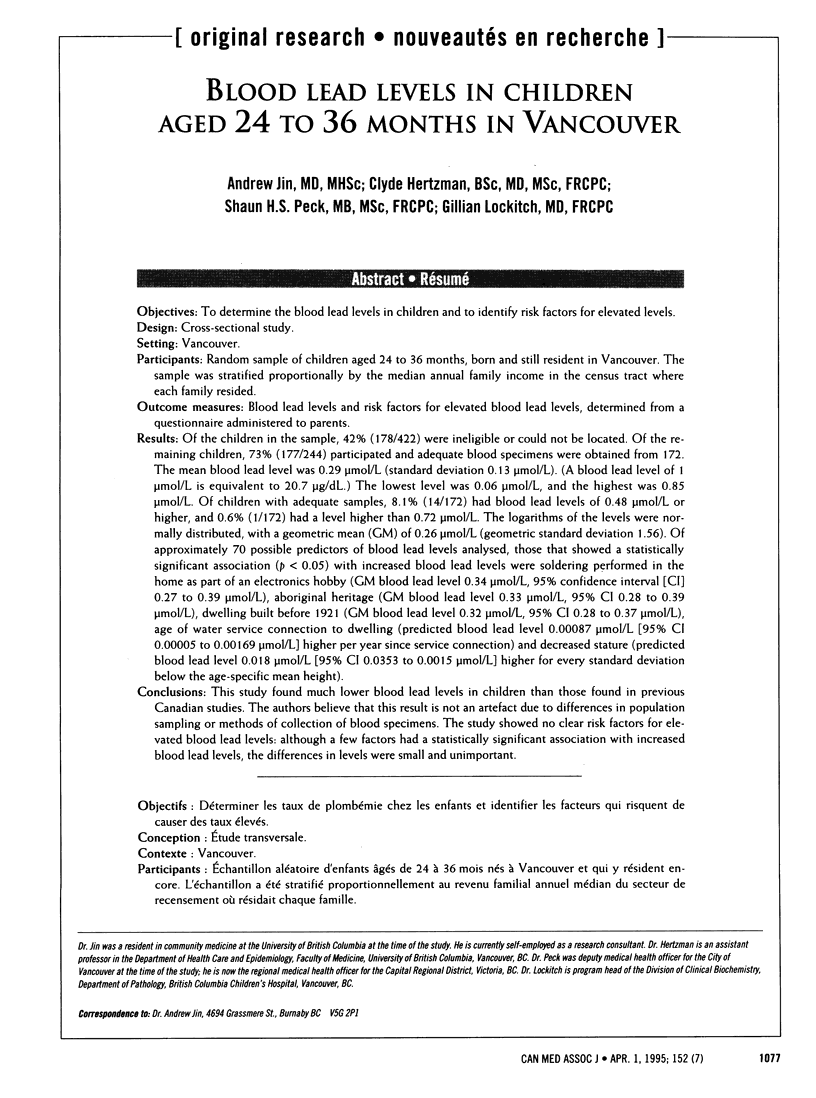
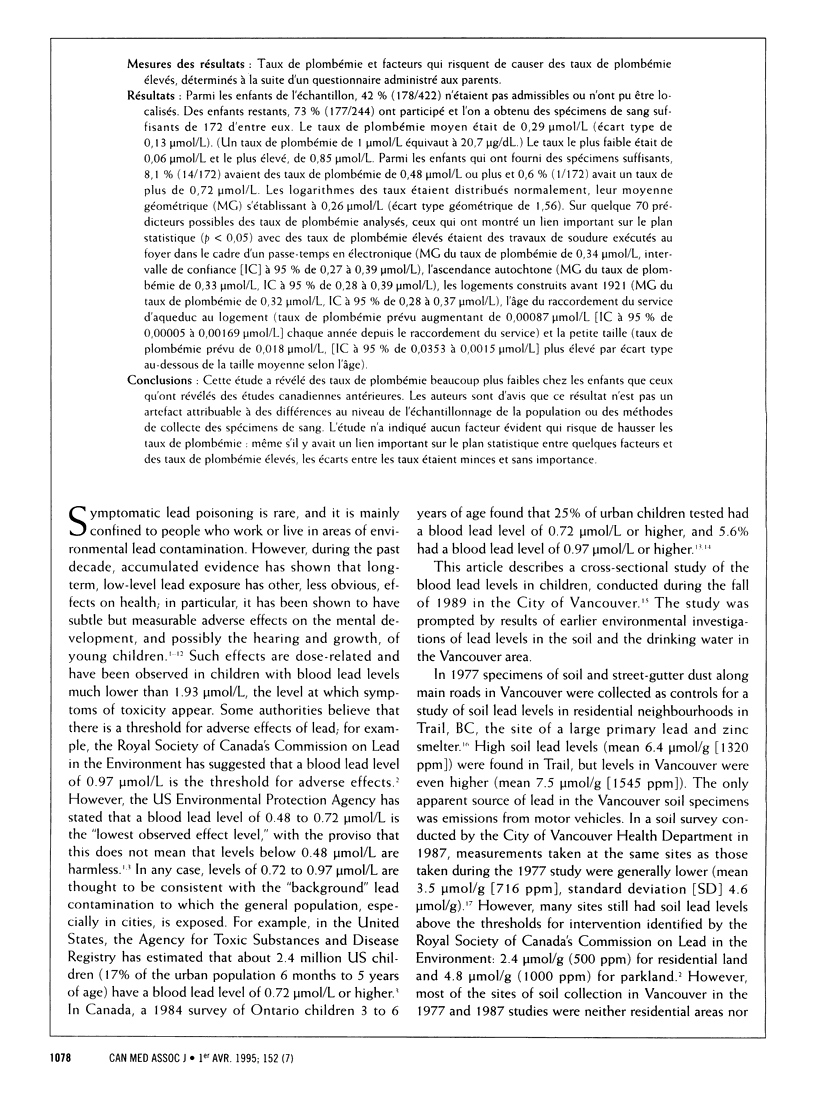

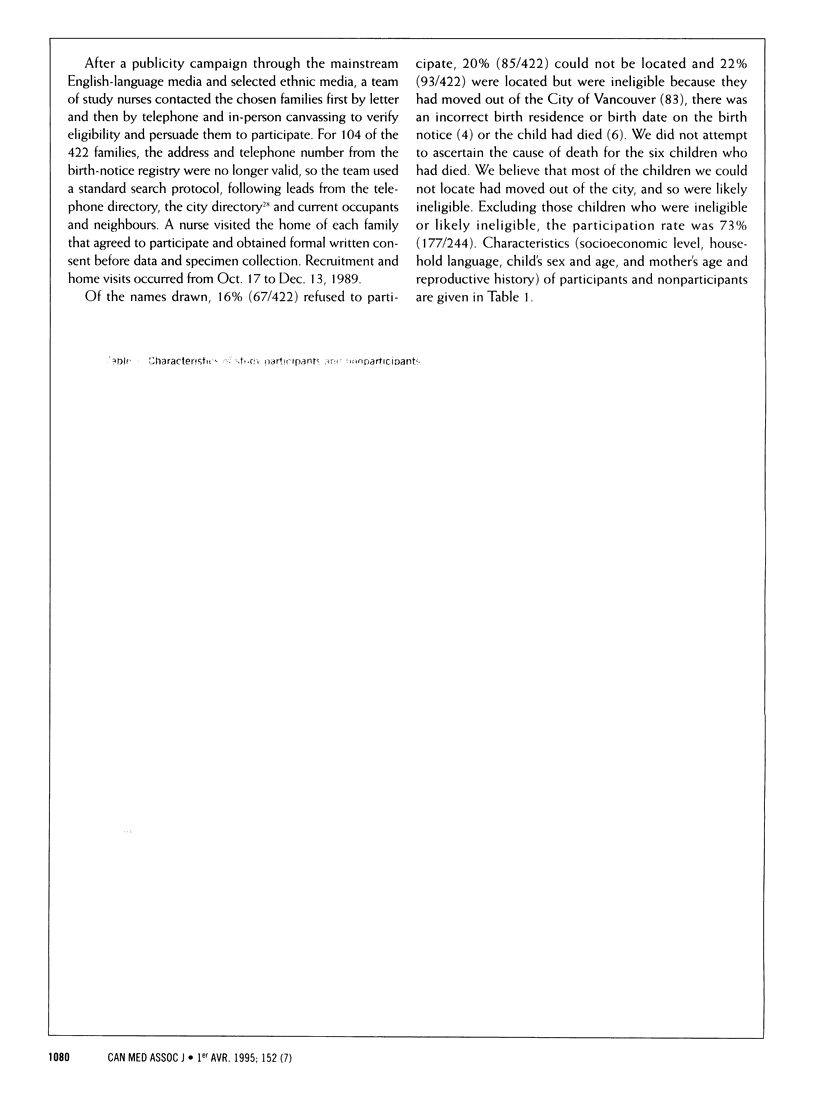
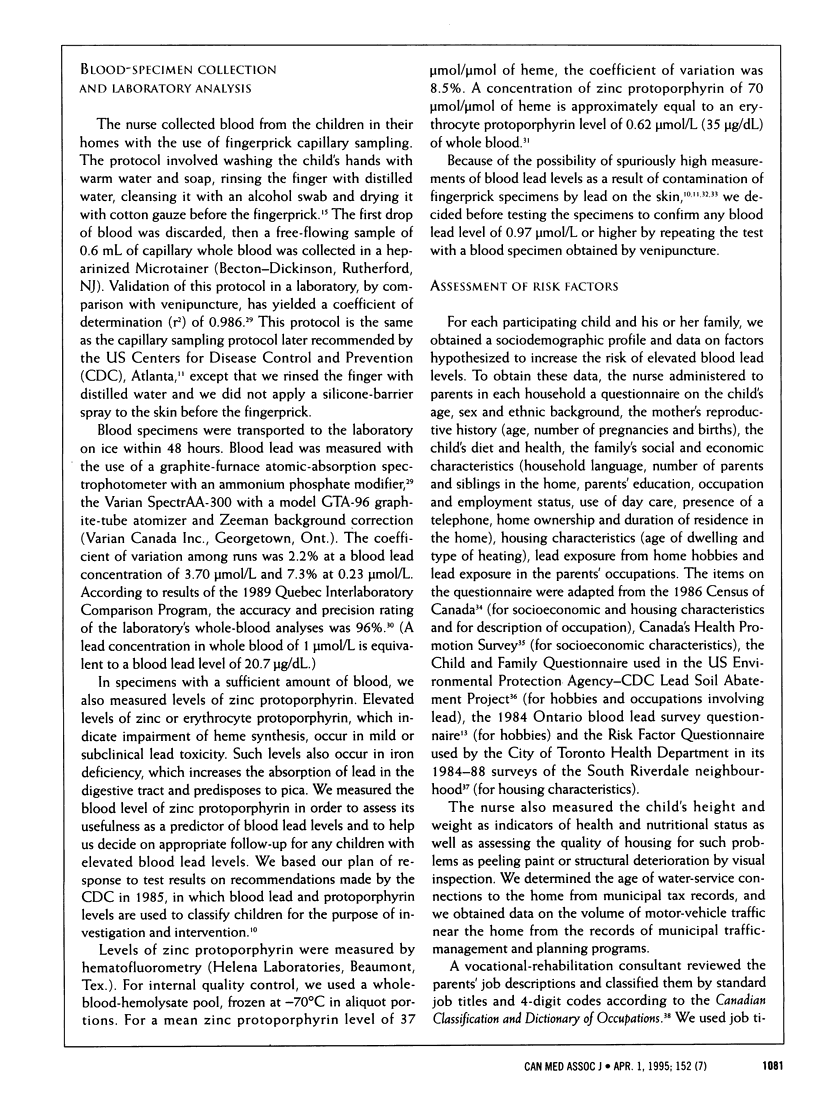
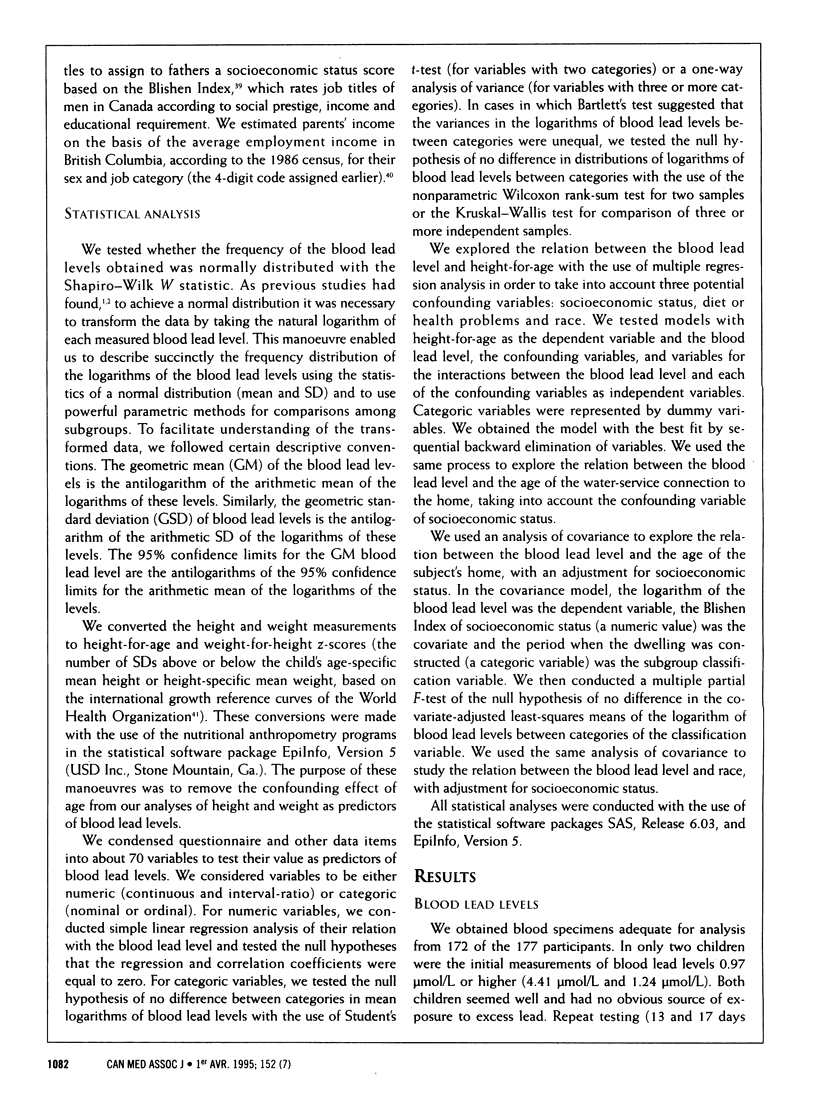


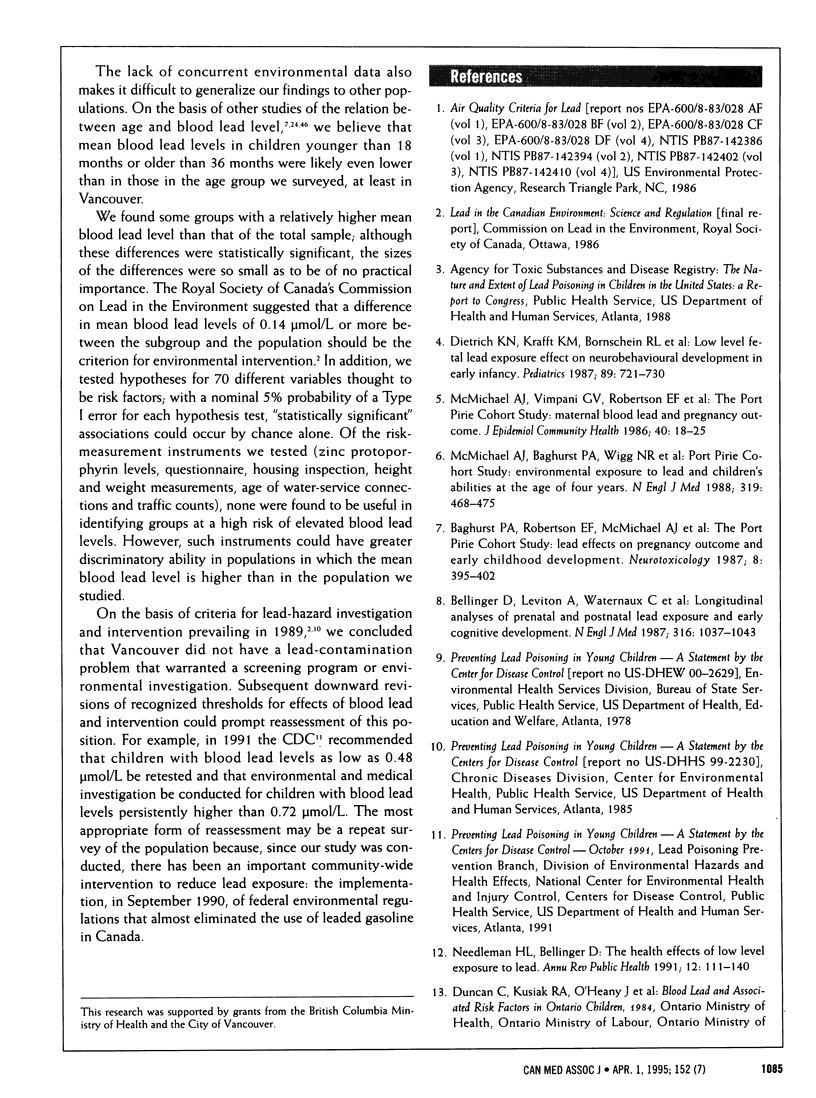
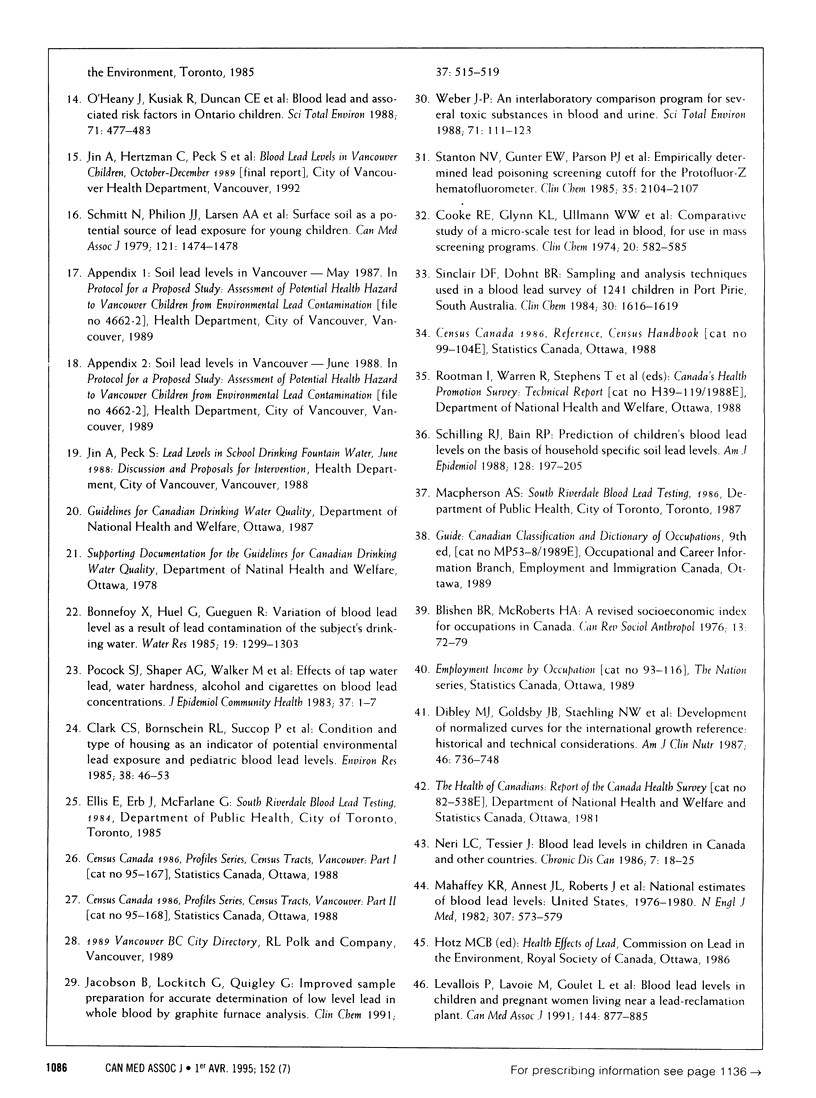
Selected References
These references are in PubMed. This may not be the complete list of references from this article.
- Baghurst P. A., Robertson E. F., McMichael A. J., Vimpani G. V., Wigg N. R., Roberts R. R. The Port Pirie Cohort Study: lead effects on pregnancy outcome and early childhood development. Neurotoxicology. 1987 Fall;8(3):395–401. [PubMed] [Google Scholar]
- Bellinger D., Leviton A., Waternaux C., Needleman H., Rabinowitz M. Longitudinal analyses of prenatal and postnatal lead exposure and early cognitive development. N Engl J Med. 1987 Apr 23;316(17):1037–1043. doi: 10.1056/NEJM198704233161701. [DOI] [PubMed] [Google Scholar]
- Clark C. S., Bornschein R. L., Succop P., Que Hee S. S., Hammond P. B., Peace B. Condition and type of housing as an indicator of potential environmental lead exposure and pediatric blood lead levels. Environ Res. 1985 Oct;38(1):46–53. doi: 10.1016/0013-9351(85)90071-4. [DOI] [PubMed] [Google Scholar]
- Cooke R. E., Glynn K. L., Ullmann W. W., Lurie N., Lepow M. Comparative study of a micro-scale test for lead in blood, for use in mass screening programs. Clin Chem. 1974 May;20(5):582–585. [PubMed] [Google Scholar]
- Dibley M. J., Goldsby J. B., Staehling N. W., Trowbridge F. L. Development of normalized curves for the international growth reference: historical and technical considerations. Am J Clin Nutr. 1987 Nov;46(5):736–748. doi: 10.1093/ajcn/46.5.736. [DOI] [PubMed] [Google Scholar]
- Dietrich K. N., Krafft K. M., Bornschein R. L., Hammond P. B., Berger O., Succop P. A., Bier M. Low-level fetal lead exposure effect on neurobehavioral development in early infancy. Pediatrics. 1987 Nov;80(5):721–730. [PubMed] [Google Scholar]
- Jacobson B. E., Lockitch G., Quigley G. Improved sample preparation for accurate determination of low concentrations of lead in whole blood by graphite furnace analysis. Clin Chem. 1991 Apr;37(4):515–519. [PubMed] [Google Scholar]
- Levallois P., Lavoie M., Goulet L., Nantel A. J., Gingras S. Blood lead levels in children and pregnant women living near a lead-reclamation plant. CMAJ. 1991 Apr 1;144(7):877–885. [PMC free article] [PubMed] [Google Scholar]
- Mahaffey K. R., Annest J. L., Roberts J., Murphy R. S. National estimates of blood lead levels: United States, 1976-1980: association with selected demographic and socioeconomic factors. N Engl J Med. 1982 Sep 2;307(10):573–579. doi: 10.1056/NEJM198209023071001. [DOI] [PubMed] [Google Scholar]
- McMichael A. J., Baghurst P. A., Wigg N. R., Vimpani G. V., Robertson E. F., Roberts R. J. Port Pirie Cohort Study: environmental exposure to lead and children's abilities at the age of four years. N Engl J Med. 1988 Aug 25;319(8):468–475. doi: 10.1056/NEJM198808253190803. [DOI] [PubMed] [Google Scholar]
- McMichael A. J., Vimpani G. V., Robertson E. F., Baghurst P. A., Clark P. D. The Port Pirie cohort study: maternal blood lead and pregnancy outcome. J Epidemiol Community Health. 1986 Mar;40(1):18–25. doi: 10.1136/jech.40.1.18. [DOI] [PMC free article] [PubMed] [Google Scholar]
- Needleman H. L., Bellinger D. The health effects of low level exposure to lead. Annu Rev Public Health. 1991;12:111–140. doi: 10.1146/annurev.pu.12.050191.000551. [DOI] [PubMed] [Google Scholar]
- O'Heany J., Kusiak R., Duncan C. E., Smith J. F., Smith L. F., Spielberg L. Blood lead and associated risk factors in Ontario children. Sci Total Environ. 1988 Jun 1;71(3):477–483. doi: 10.1016/0048-9697(88)90221-5. [DOI] [PubMed] [Google Scholar]
- Pocock S. J., Shaper A. G., Walker M., Wale C. J., Clayton B., Delves T., Lacey R. F., Packham R. F., Powell P. Effects of tap water lead, water hardness, alcohol, and cigarettes on blood lead concentrations. J Epidemiol Community Health. 1983 Mar;37(1):1–7. doi: 10.1136/jech.37.1.1. [DOI] [PMC free article] [PubMed] [Google Scholar]
- Schilling R. J., Bain R. P. Prediction of children's blood lead levels on the basis of household-specific soil lead levels. Am J Epidemiol. 1988 Jul;128(1):197–205. doi: 10.1093/oxfordjournals.aje.a114941. [DOI] [PubMed] [Google Scholar]
- Schmitt N., Philion J. J., Larsen A. A., Harnadek M., Lynch A. J. Surface soil as a potential source of lead exposure for young children. Can Med Assoc J. 1979 Dec 8;121(11):1474–1478. [PMC free article] [PubMed] [Google Scholar]
- Sinclair D. F., Dohnt B. R. Sampling and analysis techniques used in a blood lead survey of 1241 children in Port Pirie, South Australia. Clin Chem. 1984 Oct;30(10):1616–1619. [PubMed] [Google Scholar]
- Stanton N. V., Gunter E. W., Parsons P. J., Field P. H. Empirically determined lead-poisoning screening cutoff for the Protofluor-Z hematofluorometer. Clin Chem. 1989 Oct;35(10):2104–2107. [PubMed] [Google Scholar]
- Weber J. P. An interlaboratory comparison programme for several toxic substances in blood and urine. Sci Total Environ. 1988 Apr;71(1):111–123. doi: 10.1016/0048-9697(88)90305-1. [DOI] [PubMed] [Google Scholar]


